The OCZ Trion 150 SSD Review
by Billy Tallis on April 1, 2016 8:00 AM ESTMixed Random Read/Write Performance
The mixed random I/O benchmark starts with a pure read test and gradually increases the proportion of writes, finishing with pure writes. The queue depth is 3 for the entire test and each subtest lasts for 3 minutes, for a total test duration of 18 minutes. As with the pure random write test, this test is restricted to a 16GB span of the drive, which is empty save for the 16GB test file.
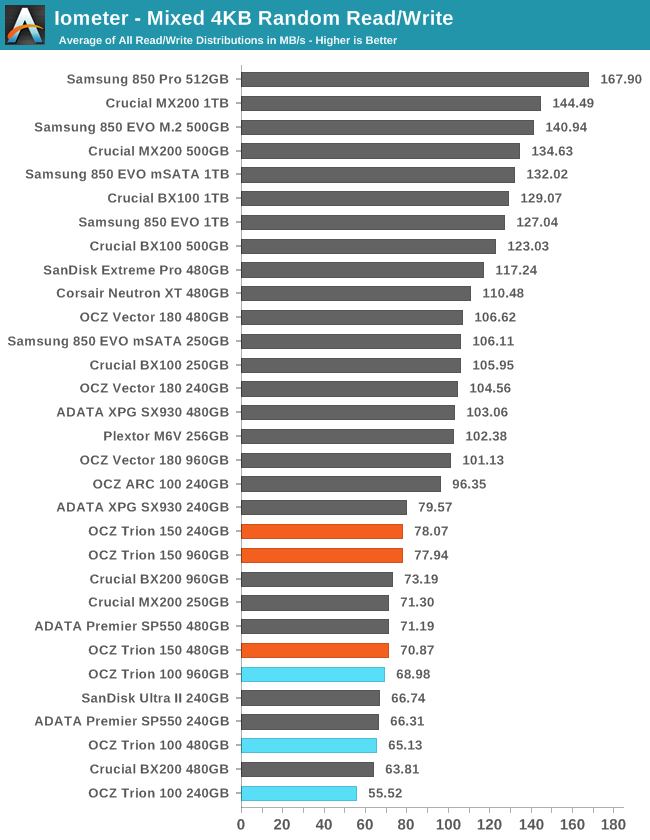
The 240GB Trion 150 once again shows surprising improvement compared to both its predecessor and its larger siblings, and all capacities handle the mixed random workload as well as any budget TLC drive.
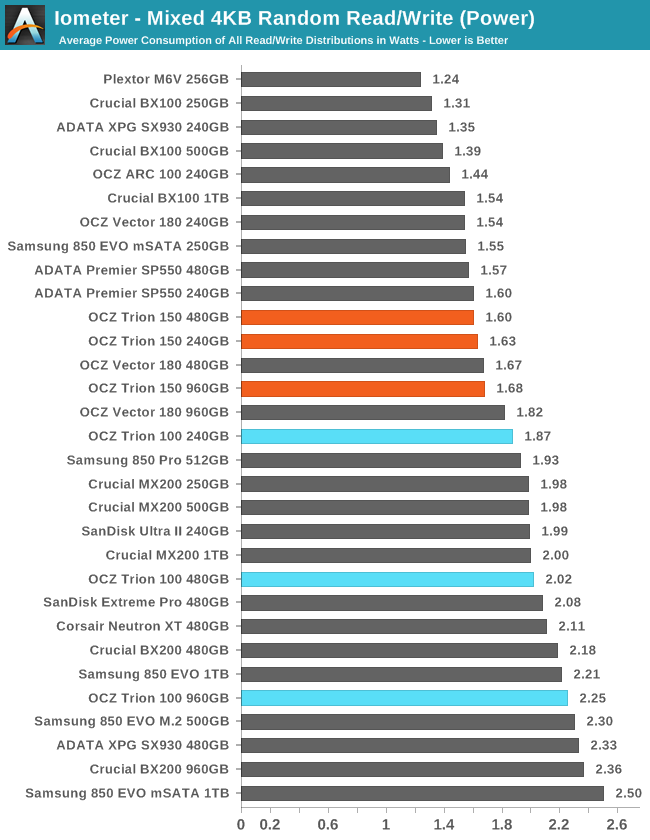
The Trion 150 shows less variation in power consumption across capacities, and better efficiency than the competition.
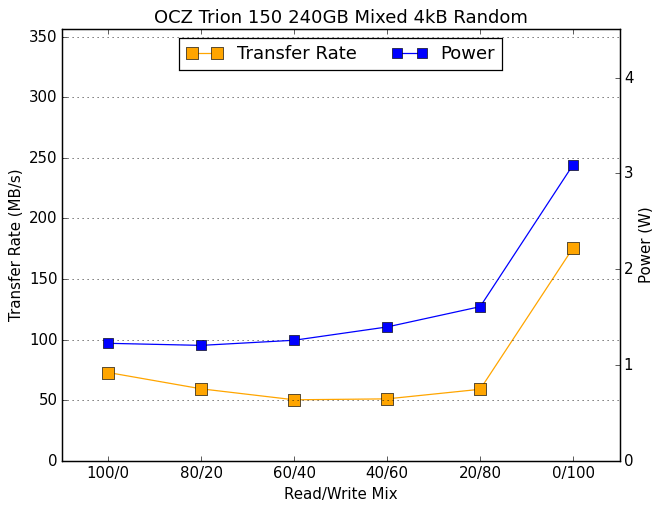 |
|||||||||
The 240GB Trion 150's relatively impressive score is due mostly to the good performance on the pure write phase at the end of this test. The larger capacities don't benefit quite as much at the end, but do score slightly higher on the other portions of the test.
Mixed Sequential Read/Write Performance
The mixed sequential access test covers the entire span of the drive and uses a queue depth of one. It starts with a pure read test and gradually increases the proportion of writes, finishing with pure writes. Each subtest lasts for 3 minutes, for a total test duration of 18 minutes. The drive is filled before the test starts.
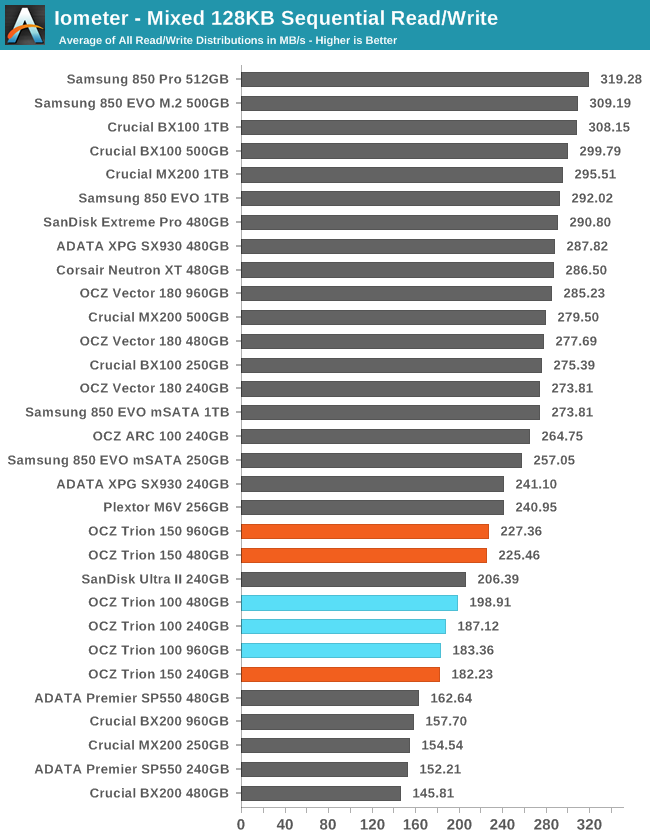
The 240GB Trion 150 is barely slower than its predecessor on the mixed sequential test, but the larger capacities perform much better and are close to matching the slowest MLC drives.
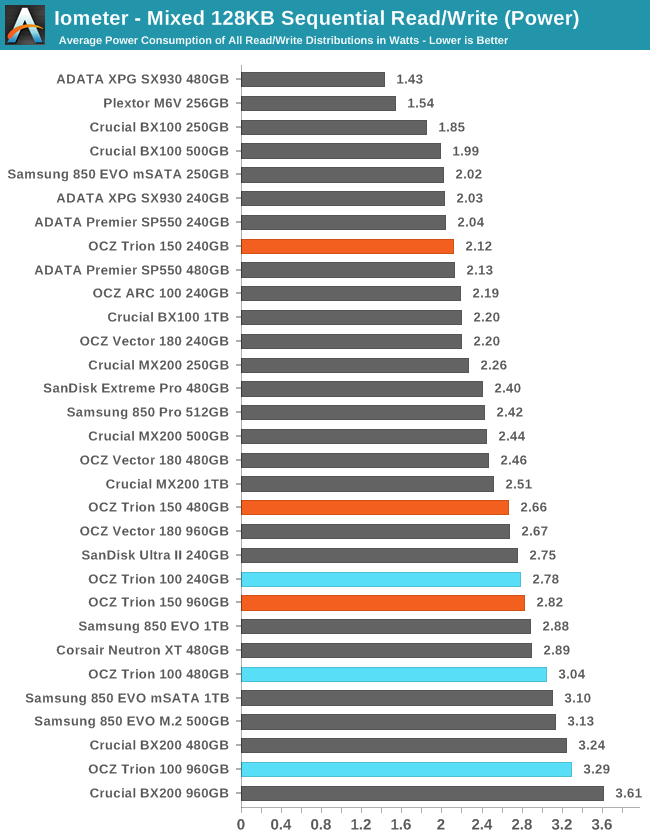
The Trion 150 continues to show improved power efficiency compared to the Trion 100, and once again manages to beat the other planar TLC drives.
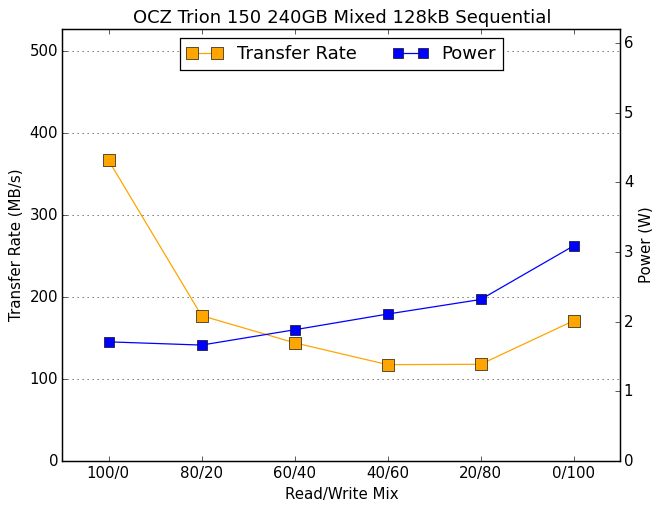 |
|||||||||
Quite differently from the mixed random test, on this test the 240GB Trion 150's score is hurt by the performance on the pure write phase. All three capacities manage to show a performance spike at the end of the test, which is absent from the worst scoring drives.










79 Comments
View All Comments
Arnulf - Friday, April 1, 2016 - link
So not only is this a low-end drive, it's an OCZ low-end drive.Thanks for the article and giving consumers heads-up so that we don't get burned!
Arnulf - Friday, April 1, 2016 - link
Ugh, EDIT function pretty please ...So not only is this a low-end drive, it's an overpriced OCZ low-end drive.
close - Friday, April 1, 2016 - link
I wouldn't call this a "burn" but it's definitely a warm beer after a hot summer day.LB-ID - Friday, April 1, 2016 - link
<Wanders in, sees another OCZ drive review><Reads the review, sees nothing has really changed>
<Wanders out to buy from a reputable brand>
Samus - Saturday, April 2, 2016 - link
I now feel like Toshiba is a Trojan horse, because all the OCZ drives that were in the buffer during bankruptcy and released after Toshiba initially bought them, in particular the exceptional ARC 100, were a sign they were turning things around.Then Toshiba releases this crap under the OCZ name. WTF are they thinking OCZ is a performance focused brand and these drives are clearly marketed at grandma's old Dell laptop.
xrror - Wednesday, April 6, 2016 - link
Yea but I think Toshiba's plan was to use OCZ for ALL of their customer facing drives. Before they bought OCZ they simply didn't offer retail drives at all!As far as a Toshiba Trojan horse... Toshiba actually had a competent drive itself right before it bought OCZ.
The Toshiba THNSNH drives were actually good (they don't bench awesome, but they're good) but since they were OEM only you've never heard of them. THNSNH was also a big jump from Toshiba's prior drives that seemed mostly made for industrial (performance wasn't great, but HDD wouldn't handle vibration/shock).
Bonus that Toshiba kept OCZ's in development models, so you had the ARC series come out. (vs. something ... not so nice like continuing Octane). But those were Marvell (I think) based with Indilinx firmware? Nothing wrong at all with that, but I imagine Toshiba's shareholders would question why they weren't using native Toshiba tech...
I'm actually really glad Toshiba of anyone (also, a surprise!) was able to snag the OCZ engineering team. Yea everyone loves to hate on OCZ, but OCZ really was the first company to so extremely aggressively bring SSD drives to the consumer market. Everyone likes to hate on Ryan Petersen but damnit, he really DID push to make SSD drives an affordable "thing" much MUCH sooner than just Intel alone would have.
They had a really rough time pounding out the bugs with SandForce yes... but seriously - who could have predicted that? (no, SERIOUSLY - before the kneejerk reaction, imagine being in OCZ's development shoes - that had to be really tough cause each time they thought they had it fixed, and it was always something very subtle). I always find it interesting that everyone forgets that their Indilinx controllers just worked - but they weren't the "sexy" fastest.
Saying that, I totally understand people who... after forking out their $600+ on a drive and having failure after RMA failure after "no this firmware really fixes it honest" failure upon failure would yea... swear off OCZ forever. But today's OCZ isn't that. Different time, place, era.
This comment has gone way too long. And I've lost my point lol.
And so you all don't think I'm a forgive and forget person. I'll never buy another Kingston product after the asshattery with the V300. When a company basically tells Anand himself to piss off when they bait and switch the NAND used...
http://www.anandtech.com/show/7763/an-update-to-ki...
Hey, at least Ryan Peterson and OCZ back then was super responsive to Anand directly when they got ripped a new one ;)
xrror - Wednesday, April 6, 2016 - link
Ugh, and I just realized I didn't address the part of using the OCZ name for non-performance parts.Basically, unless you're Samsung right now nobody is a performance part. And so that doesn't sound like a hipster "well, duh" answer - Samsung went crazy (awesome!) insane mad R&D into controllers and 3D NAND. Holy moly they even kicked Intel's butt enough so that Intel announces vaporware crosspoint memory.
I mean, halo effect in SATA market at least is crazy! SanDisk has some very extremely competitive models in their high end - but because they're maybe 3% slower in some benchmarks? Nobody on the street cares. That's nuts.
I dunno, I guess my point is that unless Toshiba/OCZ can somehow squeeze 12Gb/s through a SATA 3 link (I joke) they're not going to be able to market as a performance product these days.
Actually, the killer solution I think is to make an SSD controller that is both power efficient and makes TLC NAND not suck (so much). And that's not easy. At all. Cause small process planar TLC really a physics nightmare. I mean that's taking crappy flash drive memory and getting it to perform. Not easy.
leexgx - Sunday, April 24, 2016 - link
maybe i been unlucky i had to many sandisk SSDs (3) and SD (more than 5) cards fail (failing as what is in my phone right now about to funny enough change it for a 32GB EVO+)i do wish they would make more SSDs like the BX100 its the most power effect SSD i have ever seen (the BX200 and MX200 the very bad) BX100 is not very fast for a SSD but in laptops its very low power
jasonelmore - Saturday, April 2, 2016 - link
Still mad about that OCZ rebate scandal i see.Leyawiin - Sunday, April 3, 2016 - link
No, its a Toshiba low end. Do try and keep up.